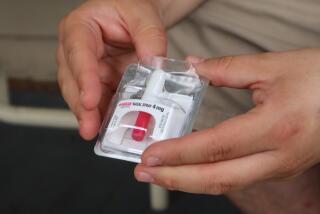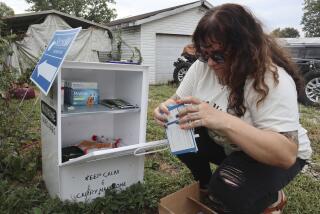Drug overdose prevention could be right at our fingertips
What do you think is the leading cause of accidental death in California?
If you said car accidents, you were wrong. In 2009, the most recent year for which statistics are available, 3,200 people in the state died in automobile crashes, while 3,561 people died of drug overdoses, the bulk of them involving prescription pills.
That high number of deaths is particularly tragic because we have a powerful weapon against drug overdoses, and it isn’t used nearly as often as it could be.
Naloxone (trade name: Narcan) is a low-cost, generic drug approved by the FDA in 1971. Talk to any cop, firefighter or emergency room doctor, and they know all about its ability to reverse a potentially fatal opiate overdose. The drug is easy to administer, either as an intramuscular injection or through a nasal spray, and it has no negative side effects. But many of the people most likely to discover someone in need of naloxone have never heard of it.
When I found this out, I wanted to run to the nearest drugstore, buy it up and start handing it out. It seemed to me almost as much a no-brainer as condom distribution for preventing AIDS. Using naloxone is, of course, a little more complicated than using condoms for AIDS prevention because it requires a prescription to obtain it and a third a party to administer it. But the basic idea is the same: Those who engage in potentially risky behavior should be encouraged to take precautions.
What would that mean? People using prescription painkillers to treat chronic pain — along with those who might misuse drugs — would be taught to keep naloxone on hand and to make sure someone in the household knows how to use it. It would be a bit like people with life-threatening bee allergies carrying EpiPens, which deliver a single dose of easily administered epinephrine in case of a sting.
There’s no good reason naloxone is so underutilized: It’s simply a failure of education and planning. It’s not a narcotic and has no recreational use. You can’t get addicted to it. Its only purpose is to reverse an opiate overdose, which it does by ejecting opiods from receptors in the brain, thus reversing the respiratory depression that can lead to death.
So what are the barriers to its routine use?
The first is that most physicians aren’t trained to offer it, even when they are treating people who abuse drugs or when prescribing opiates to those in severe pain. All physicians prescribing medications such as oxycodone or hydrocodone, which carry with them the risk of an overdose, should consider also prescribing precautionary naloxone.
Another barrier is that naloxone is not on the state Medicaid formulary, and many insurers do not automatically cover it, even for patients receiving opiates. Doctors may have to seek a pre-authorization to prescribe it, an unnecessary hoop that public health advocates are working to fix.
Even some emergency personnel don’t have access to naloxone. The highly trained paramedics employed by most big-city fire departments are likely to carry the drug and to administer it to any unconscious person who appears to have suffered an overdose. But each county’s emergency medical services authority determines what level of training its first responders are required to have and what supplies they carry. Lassen and Modoc counties, for example, don’t require their entry-level emergency personnel, who include EMT-1s and volunteers, to be trained to carry and use naloxone.
One way to remove barriers would be to make the drug available over the counter, something Nora Volkow, head of the National Institute on Drug Abuse, has said she supports. Last year, when the FDA held hearings on the drug, only one person spoke against that idea. But regulatory hurdles along with marketing issues must be addressed before it can happen.
In the meantime, broader use of naloxone, in conjunction with overdose prevention education, is already working in some places. Massachusetts, for example, has deployed the drug widely, with considerable success. Closer to home, San Francisco has also made significant progress in preventing overdose deaths. In the late 1990s the city had more than 160 heroin overdoses a year. In 2003, an overdose prevention, education and training program was implemented that included providing naloxone to at-risk individuals. Last year, San Francisco had only eight heroin overdoses. The total cost of the program is $70,000 a year, and it has reduced emergency room visits for heroin overdoses by 49%. This year, the program is being expanded to ensure that all pain patients treated at county clinics get overdose prevention training and naloxone by prescription.
And there are efforts to build on that success. Assemblyman Richard Bloom (D-Santa Monica) is sponsoring legislation, AB 831, to dedicate $500,000 to fund overdose prevention programs throughout the state, including naloxone prescription and training programs. Another bill, AB 635, introduced by Assemblyman Tom Ammiano (D-San Francisco), would encourage physicians statewide to prescribe naloxone to patients and would distribute the antidote through public health programs.
It’s rare that a leading cause of death is so preventable, which makes the underutilization of naloxone all the more tragic. We need to ensure that it is available wherever it might save lives.
Lynne Lyman is California state director for the Drug Policy Alliance.
More to Read
A cure for the common opinion
Get thought-provoking perspectives with our weekly newsletter.
You may occasionally receive promotional content from the Los Angeles Times.










